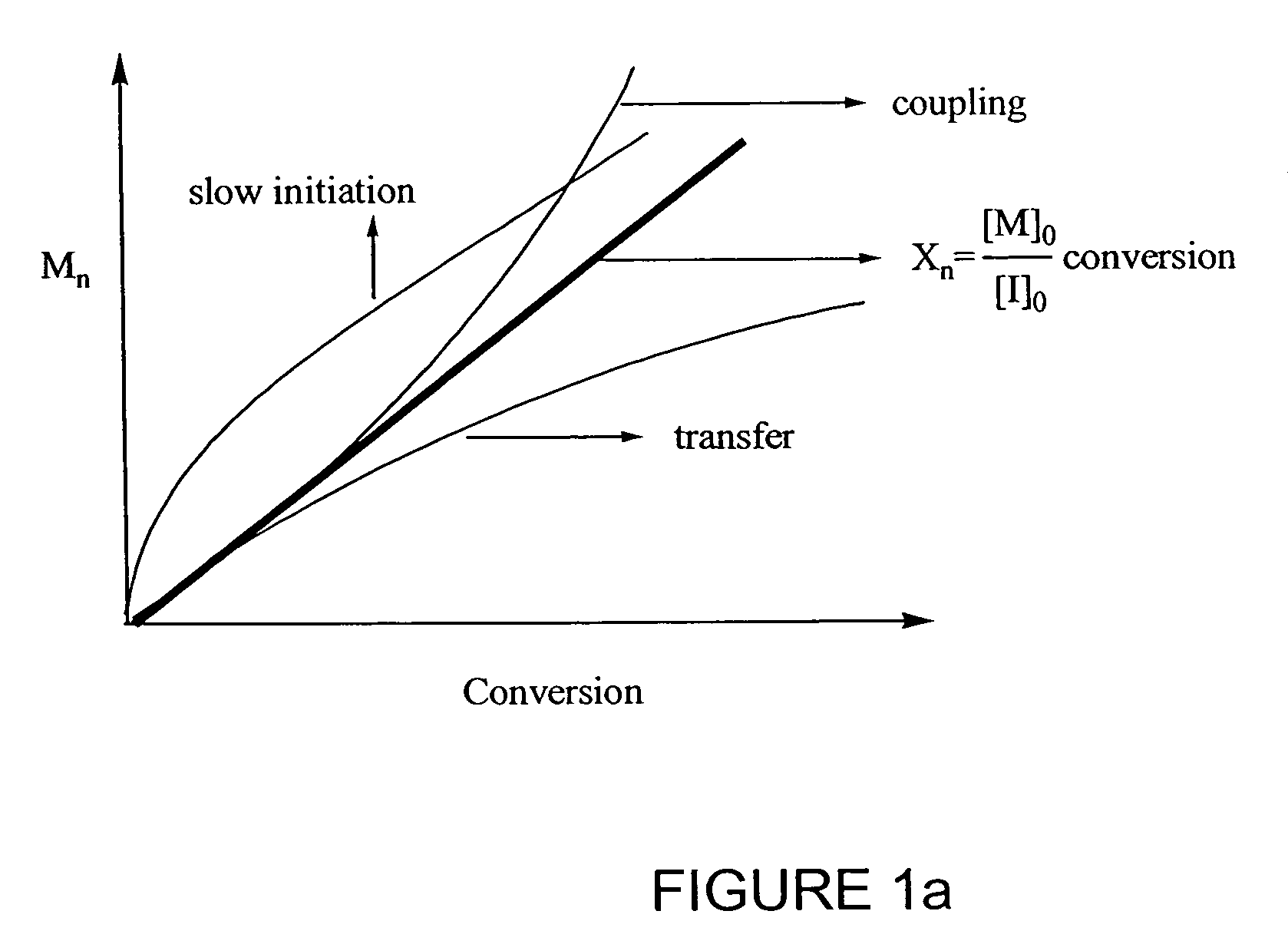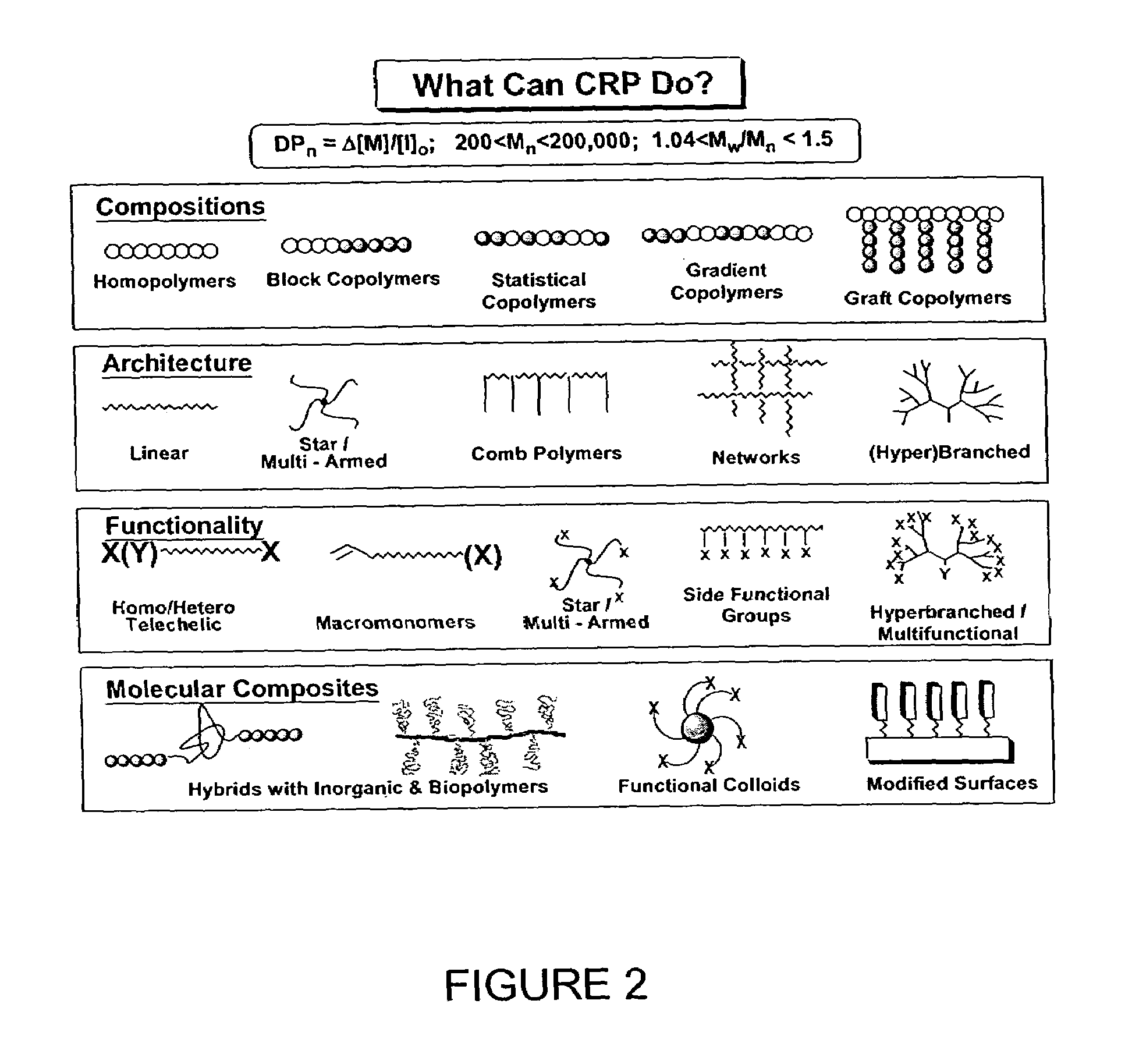Catalyst system for controlled polymerization
a technology of controlled polymerization and catalyst system, which is applied in the direction of physical/chemical process catalysts, organic compound/hydride/coordination complex catalysts, chemical/physical processes, etc., can solve the problems of inability to control the polymerization process, the presence of transition metal complexes, and the inability to achieve the control of the polymerization
- Summary
- Abstract
- Description
- Claims
- Application Information
AI Technical Summary
Problems solved by technology
Method used
Image
Examples
example 1
Preparation of PSbead(8 μm)-bpyCuBr Catalyst
1a. Preparation of PSbead(8 μm)-bpy Ligand:
[0082]Feedstock Recipe; PS bead-Cl, 16 g containing 1.104e-2 mol Cl; Dmbpy 10.172 g or 5.521e-2 mol; (IPr)2NH 7.74 mL, 5.521e-2 mol; nBuLi 34.5 mL, 5.521e-2 mol; CuBr 0.3077 g, 2.145e-3 mol (1.2 molar excess).
[0083]After purging the oxygen from a three neck 250 mL round bottom flask by charging with N2 follow by vacuum 80 mL of dry THF and 7.8 mL of (iPr)2NH were added after cooling in a dryice / acetone bath. 34.5 mL of n-BuLi was slowly added to this mixture and the resulting reaction mixture was further stirred at −78° C. for 2 h. A solution of dMbpy predissolved in fresh THF was introduced dropwise to the resulting mixture and further stirred at −78° C. for 2 h. In a separate round bottom flask 16 g Psbead-CI was suspended in dry THF under nitrogen purge. The (IPr)2NH / nBuLi / dMbpy solution was transferred to the PSbead suspension by cannula at −78° C. The reaction temperature was allowed to incre...
example 2
An Alternate Preparation of Polystyrene Bead Supported bpy-CuBr Catalyst
2a. Preparation of PSbead(8 μm)-bpy-CuBr Catalyst—PS(S)-bpy-102700-1
[0086]Recipe: PS bead-bpy 1.79 g; 2.06e-3 mol bpy ligand; CuBr 0.2956 g, 2.06e-3 mol Temperature=60° C., reaction time=overnight (˜14 h), solvent=THF 70 mL. 1.79 g of PS bead(8 μm)-bpy and 0.2956 g of CuBr were added to 100 mL Schlenk flask and deoxygenated by evacuation with high vacuum and refilled with dehydrated nitrogen three times. 70 mL of THF was added to the flask to suspend the reagents and the temperature was increased to 60° C. The reaction mixture was stirred at that temperature for 14 h. The resulting product was washed thoroughly three times with 60 mL of deoxygenated THF, once with 60 mL of deoxygenated toluene, and twice with 60 mL of deoxygenated hexane. The dark brown catalyst was dried under vacuum and stored under dry nitrogen in glove box.
2b. Preparation of PSbead(8 μm)-bpy-CuBr2 Catalyst—PS(S)-bpy-102700-2
[0087]In order to...
example 3
Activation of Commercial Resins
3a. Supported Amine Ion Exchange Resins.
[0090]Three different kind of anion exchange resin were obtained from Dow. Resins identified as M4195 and XVS 43578 contain bispicolylamine as an attached ligand, XVS43578 has a more uniform particle size distribution and HPPA contains hydroxypicolylamine functionality. The resins have amine functionality in the form of sulfate salts. Therefore it is necessary to neutralize them prior to use and provide resins with attached free amine which can play a role of ligand in an ATRP catalyst. The resins were first washed with fresh distilled water for 18 h followed by neutralization with 1M NaOH just to alkaline by PH paper (No change of PH for at least two hours should be confirmed). During this neutralization procedure the color of the resins change from yellow to brown. The resins were washed with fresh water and methanol. The obtained resins were dried under vacuum for 6 h at 60° C. The amount of free amine ligands...
PUM
| Property | Measurement | Unit |
|---|---|---|
| polydispersity | aaaaa | aaaaa |
| polydispersity | aaaaa | aaaaa |
| molecular weight distribution | aaaaa | aaaaa |
Abstract
Description
Claims
Application Information
 Login to View More
Login to View More - R&D
- Intellectual Property
- Life Sciences
- Materials
- Tech Scout
- Unparalleled Data Quality
- Higher Quality Content
- 60% Fewer Hallucinations
Browse by: Latest US Patents, China's latest patents, Technical Efficacy Thesaurus, Application Domain, Technology Topic, Popular Technical Reports.
© 2025 PatSnap. All rights reserved.Legal|Privacy policy|Modern Slavery Act Transparency Statement|Sitemap|About US| Contact US: help@patsnap.com



